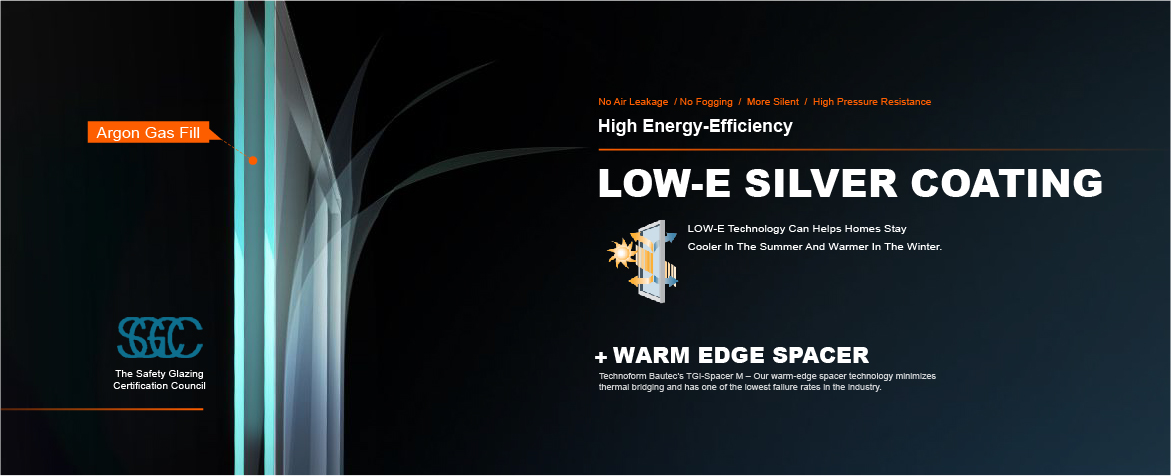The word "energy efficiency" is undoubtedly one of the most frequent words in recent years. An environmental report says that in the next coming 20 years, the most energy consumed thing is not industry, not transportation, but our house. Although this statement is somewhat exaggerated, but not without reason.
According to statistics, building energy consumption accounts for about one-third of the total energy consumption, in all buildings, 99% belong to high-energy consumption buildings, and even for new buildings, more than 95% are still high-consumption buildings. The energy consumption of doors and windows, in turn, occupies a large proportion of the building’s energy consumption, windows and doors have the worst thermal insulation performance compared to walls, roofs, and floors, and the energy consumption of windows and doors accounts for 40% to 50% of the total energy consumption of the building.

Comfort and natural, environmental protection, and energy saving are gradually becoming the guidelines for international architecture in the new century, and building’s good capacity of energy efficiency has become a worldwide trend. In short, windows and doors’ energy efficiency can be said to be extremely important, not only about the sustainable development of the earth's energy but also about your home this month's electricity and heating bills, although it sounds like a very far-away thing everyone is deeply involved in it.

We have a lot of projects in the USA and Canada, and we are well known for the local building code requirements. Due to the climatic characteristics of each city, there are very clear requirements for the insulation performance of windows, so our products have the NFRC certifications to ensure that your project will pass the inspection after completion of your project.
Depending on the orientation of the windows and doors in the house, different SHGC values’ glazing will be used. Doorwin glazing will be customized with caution on the sun-facing windows to help with overheating in summer and also will keep you warmer in the winter while cutting on energy costs.

Our energy-efficient integrated glazing units (IGU) feature double-pane or triple-pane glasses, warm-edge spacers, argon gas fill, Low-E coatings, and fully tempered or laminated glass, they can not only create a comfortable and natural indoor environment but also save electricity bills and heating bills around 100~300USD per month according to your whole building’s fenestration areas. That’s a real bargain compared to choosing a regular glazing set.

mproving the thermal resistance of the frame can contribute to a window's overall energy efficiency, particularly its heat loss rate or U-factor. Doorwin only uses the most energy-efficient profiles to forge frames and sashes:
A “thermal break” by splitting the frame components into the interior and exterior pieces and using a less conductive material to join them. Doorwin’s exclusive thermal break aluminum
profiles have decreased aluminum frame U-factors (heat loss rate) from roughly 2.0 to about 1.0 Btu/hr-sq.
Aluminum itself has a very poor insulating function but after the
process with a thermal break, it had quite good insulation ability.

The traditional window frame material is wood, because of its availability and ease of milling into the complex shapes required to make windows. Wood is favored in many residential applications because of its appearance and traditional place in house design. From a thermal point of view, wood-framed windows perform well with frame U-factors in the range of 0.3 to 0.5 Btu/hr-sq.
According to the finishing process and the type of wood.

Doorwin provides a variation of the wood-framed window to clad the exterior face of the frame with aluminum, creating a permanent weather-resistant surface. Clad frames thus have lower maintenance requirements, while retaining the attractive wood finish on the interior.
As the same as solid wood, alu-clad wood windows also have good insulation ability.

In most windows, the most important decision regarding energy efficiency is the selection of the glazing. Based on various window design factors such as window orientation, climate, building design, etc., you may even want to choose different types of glazing for different windows throughout your home.
Low-E, which represents low emission, is a film system consisting of multiple layers of metal or other compounds coated on the glass surface. The coating layer has the characteristics of high transmission of visible light and high reflection of middle and far infrared rays, which makes it have an excellent heat insulation effect and good light transmission compared with ordinary glass and old-fashioned architectural coated glass.
Low-E glazing's infrared transmission can be less than 0.06, which means that most of the radiations are reflected, and the sunburn sensation is significantly reduced as the comfort level is increasing.
What if you live in a super cold area? If the infrared heat transmittance ratio of glazing is so low, how can I sunbathe in winter? Depending on the orientation of the windows and doors in the house, different glazing will be used.
Doorwin’s Low-E laminated glazing will be customized with caution on the sun-facing windows to help with overheating in summer and also will keep you warmer in the winter while cutting on energy costs

In order to minimize heat transfer between the interior and exterior of the window, the space between All Doorwin’s glazing layers is filled with Argon Gas.
Spacers with associated sealants are used to keep the layers of glazing the correct distance apart. In addition, they provide accommodation for thermal expansion and pressure differences, while also preventing moisture and gas leaks.
Doorwin cooperates with the world’s top warm-edge spacer brand Technoform Bautec™ , to lower window U-factor and significantly reduce condensation at the edge of windows.

Contact us for specific configurations
Due to the climatic characteristics of each city, there are very different requirements for the insulation performance of windows, please feel free to contact us anytime, talk to us with your own ideas and project details would be nice.
